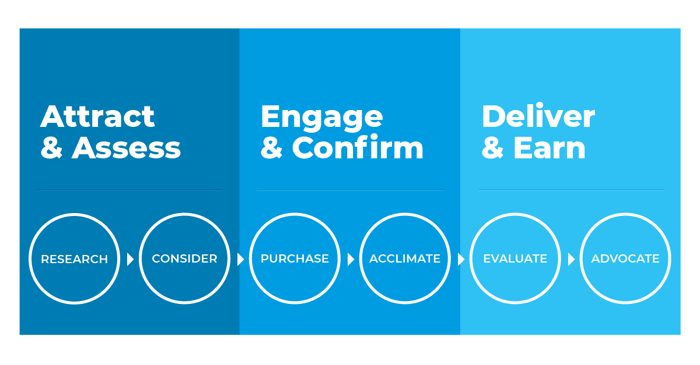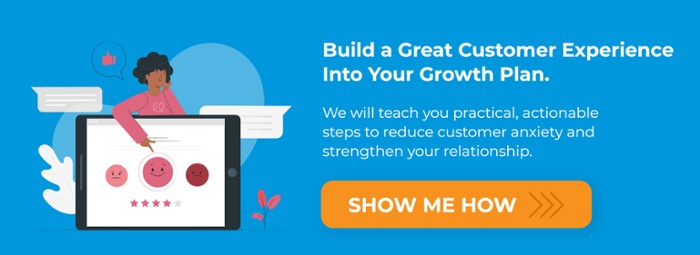
How Healthcare Brands Create Excellent Customer Experiences
Patrick Dodge
Founder
The customer experience revolution is coming. Is your brand ready?
The word is out all over the marketing community. Customers are now in complete control of the buying process and they wield enormous power over your brand. A long customer lifecycle will help your profitability soar from reduced churn and increased referrals. A short lifecycle means spending a lot more on lead generation and sales to sustain any growth.
As the market for apps, devices, lab testing, and BI solutions continues to grow, customer experience will become the greatest differentiator among brands.
Let’s unpack how to put a proactive CX strategy together, starting with the biggest reason why many companies struggle with this.
The Difference Between Service & Customer Experience
Companies struggle to create an exceptional customer experience because they don’t know what one really looks like. Most of them think that providing a responsive service department is really all it takes to ensure a great CX, but that’s not the case.
There is a big difference between offering great service and a great experience. Customer service is reactive. Your service teams are there to address issues from customers as they arise, resolving them quickly and decisively.
A good customer experience strategy, on the other hand, does two things: They identify and remove negative aspects of doing business with your brand, while finding ways to reassure and delight your clients.
Rethinking the Customer Journey
You might be wondering why I included the word “reassure” in there.
When your team is onboarding practitioners or other clinical professionals, it’s easy to lose perspective on how rough this time can be for new partners.
The euphoria clients feel about finding your solution fades shortly after the sale, leaving lots of room for uncertainty, doubt, and buyer’s remorse. You have 90 days to help them acclimate to your process and show them the promise of results. It’s scary how many businesses lose great customers because they fail to recognize how important this is.
If you need more proof, just look at the way marketers view the customer journey. As a marketer what this looks like and they will describe a tactical, linear process where they attract a visitor to the company website, convert them into a lead, and wow them until they blossom into a paying client.
This is a self-centered and inaccurate way of looking at the relationship. Instead, marketers should look at it like this:

In the top row, each phase describes how the brand serves its customers. The circles below show how customers evaluate the relationship with the brand.
Prospects will research and consider whether your brand can fulfill their needs. If things go well, they will purchase your solution and acclimate to your delivery process.
As your team works hard on delivering the promised result, the client is quietly evaluating how things are going. You might think your partnership is in great shape, but it’s risky to make assumptions. Clients often don’t share everything they think about of your brand, and it can hurt you.
Remember, your service team might spend a lot of time focusing on clients that have frequent requests and needs because the “squeaky wheel gets the grease,” but a client that never complains is just as likely to desert you.
Brands that implement a proactive strategy to deal with customer needs, both business-related and emotional, will get to the hardest position to reach with their accounts – advocacy.
Creating a Customer Experience Strategy
Your CX strategy does not need to be complicated nor expensive, but it should be authentic, personalized, and, above all else, human. Here are some practical steps to get started.
- Interview people who have evaluated and purchased a medical solution like yours. Record each interview and take notes about their experience. Pay attention to decision criteria and perceived barriers that guided their decision of who to buy from. You will discover what your buyers truly care about, and why they chose to search for a new solution when they did.
- Gather stakeholders from every department in your company and make a list of all possible friction points between customers (new and old) and your business. More than a brainstorming session about service complaints -- you want to uncover as many challenging aspects of the CX as possible.
Talking about these issues could make some of your team members uncomfortable, as it may expose shortcomings in their respective departments. Do it anyway. This effort is essential for ensuring the future health and prosperity of company, and every participant must be willing to check their egos and commit themselves to the process of serving customers better.
- Take all of the findings from the research and brainstorming and create a “Friction List.” Categorize each of them under the customer journey stages above (a comprehensive list will likely have items under each stage). Prioritize two or three issues that need fixing in each category, and assign them to team members most qualified to come up with a creative solution. Set a timeline to for all solutions to be in place (no more than 90 days later), and hold weekly or bi-weekly progress meetings to ensure everyone is on track to complete their assignments on time.
Here is an example of what this could look like:
Consider Phase
Friction: Customers are frustrated by lack of pricing information for our EMR software.
Why This Challenge Exists: Pricing depends on a variety of factors, making cost difficult to explain.
Solution: Publish a blog post or guide, explaining how different variables impact the final cost. Promote it on channels where your buyers look for information, and make it easy to find in your website navigation. You might also create a tool that collects information from prospects and enables them to see a ballpark range of costs. Give them the option of requesting a follow up call or chat with someone from sales. Some of them will say yes, some will decline, but do not make assumptions. Interest in pricing does not equal consent to a barrage of email spam!
After completing these fixes, create a plan for tackling the next round. As you work through the list, listen carefully to how customers respond to these changes and adjust as needed.
A customer experience strategy is a living, breathing process that never ends. It requires an organizational culture that thrives on honesty and transparency. People should feel secure enough in their jobs to speak openly about problems and fix them for the better of the company.
It’s a worthy endeavor. As more healthcare companies discover how a positive CX can drive revenue and create market differentiation, brands that have been in the game the longest will have a distinct advantage over the others.
Sep 10, 2019 6:51:55 AM

